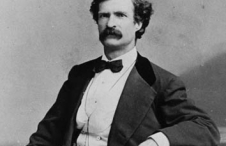Nevada Noir
The term noir, the French word for "black," refers to a particularly dark literary mood, and often to a specific narrative genre. These are stories that deal with guilt, sex, and violence, and usually a combination of all three. When transposed to the desert setting of Nevada, noir takes on an especially lonely, existential cast, tinged with mystery and isolation.
The American roman noir is the descendant of the crime and detective stories of Sir Arthur Conan Doyle, Agatha Christie, and Edgar Allan Poe. However, the type of storytelling known specifically as noir did not emerge until the early and middle twentieth century as exemplified in the work of such authors as Raymond Chandler, Dashiell Hammett, James M. Cain, and Jim Thompson. The writing of these authors is noteworthy for its terse, lean quality, obviously influenced by Ernest Hemingway, and for its tough guy, or "hard-boiled" sensibility.
American noir is always about crime of some sort, usually murder. As a consequence, many stories feature a detective or law enforcement officer as the protagonist. In other instances, the main character is a criminal, or a hapless loser who falls in lust with a dangerous woman who proceeds to convince him to commit crime on her behalf. Generally speaking, the world of the roman noir is one in which evil, perversity, and crime lurk in every corner; everyone is a prime suspect, from the blonde-haired girl next door, to the hatchet-faced thug, to the handsome and wealthy real estate chiseler. These are stories that derive their interest and effect from American paranoia, and from an apparently innate desire to see criminals in action.
Thus, in some respects, Nevada is an ideal setting for noir. The endless, desolate deserts provide a stark dramatic backdrop in which all kinds of dark dramas can play out, and in which appalling acts can be buried and hidden, perhaps never to be unearthed. Likewise, the urban cultures of both Reno and Las Vegas rely to no small extent upon temptation—quick wealth, sex, entertainment, pleasure, drunkenness, and other forms of hedonistic excess—which add up to a sort of guilt-free fantasy best summed up by the motto, "Whatever Happens in Vegas, Stays in Vegas."
The earliest examples of Nevada noir were written in the wake of the Reno divorce mill period, and include pulp titles like James Gunn's Deadlier than the Male (1942) and Helen Arre's Corpse by the River (1953). These books utilize the urban setting of Reno and its attendant reputation as a gambling and divorce mecca in order to refashion and toy with the conventions established by Spillane, Chandler, and Hammett. Despite their taking place (at least partly) in Reno, these pulpy early efforts seem to fall somewhat short in terms of "insider" knowledge of Nevada.
It is this quality—a sense of ease and understanding with the parts of Nevada which are likely to go unnoticed by non-natives—that marks the work of Bernard Schopen, the Reno-based writer whose trilogy of detective novels forms the apogee of Silver State noir. In the first book The Big Silence (1989), which probably derives its title from a Robert Laxalt essay, Schopen introduces the boozy, hard-boiled Reno detective Jack Ross, a lover of the desert who manages to find himself embroiled in a plot as complicated and labyrinthine as anything in Chandler. The book demonstrates a native's comfort with alien landscapes like the Black Rock Desert, and a keen sense of the way class and politics function in Reno's cultural climate.
The title of the second novel, The Desert Look (1990), refers to the dazed and bugged-out gaze of one who has been lost in the endless, sage-strewn hills of Nevada's deserts. In this story, Jack Ross travels southwards, to the sparsely populated central portion of the state, in order to investigate the disappearance of a Las Vegas showgirl. The trilogy concludes with what is perhaps the most finely crafted of the three, The Iris Deception (1996), a novel that draws an interesting parallel between the San Francisco Bay Area and Reno. In Schopen's hands, Reno is the friendly, homey city where one can find redemption, and San Francisco is the dark, porn-tainted sinner's metropolis. Taken as a whole, Schopen's Jack Ross trilogy is a powerful achievement, impressive both in its appropriation of noir conventions and in the way it engages elements familiar to Nevada insiders.
For purists, Schopen's three novels represent the pinnacle of Nevada noir, but there are other narratives that touch upon the basic feeling of this literary mode. Short stories such as David Kranes's "Dealer," about a blackjack dealer in Jackpot at the extreme northern border of the state, and Art Gibney's "A Hard Way to Make a Hundred Bucks," about a pair of men who sneak past the border at Area 51, both successfully juxtapose some of the gritty, criminal underpinnings of more conventional noir with elements that seem essentially Nevadan, such as the hardscrabble landscape.
Additionally, there exists the subgenre of Las Vegas and gambling stories that draw upon the "sinful" feeling of the gaming industry in order to spin tales that occasionally touch upon the heart and soul of noir. Salient examples include Felicia Campbell's "The God Gambler," Mario Puzo's Fools Die, John Gregory Dunne's Vegas: A Memoir of a Dark Season, and H. Lee Barnes's The Lucky. These gambling and Las Vegas stories, while not noir in the purest, most rigid sense, nonetheless explore the themes of guilt, crime, luck and lust, which are common to this classically American genre.


